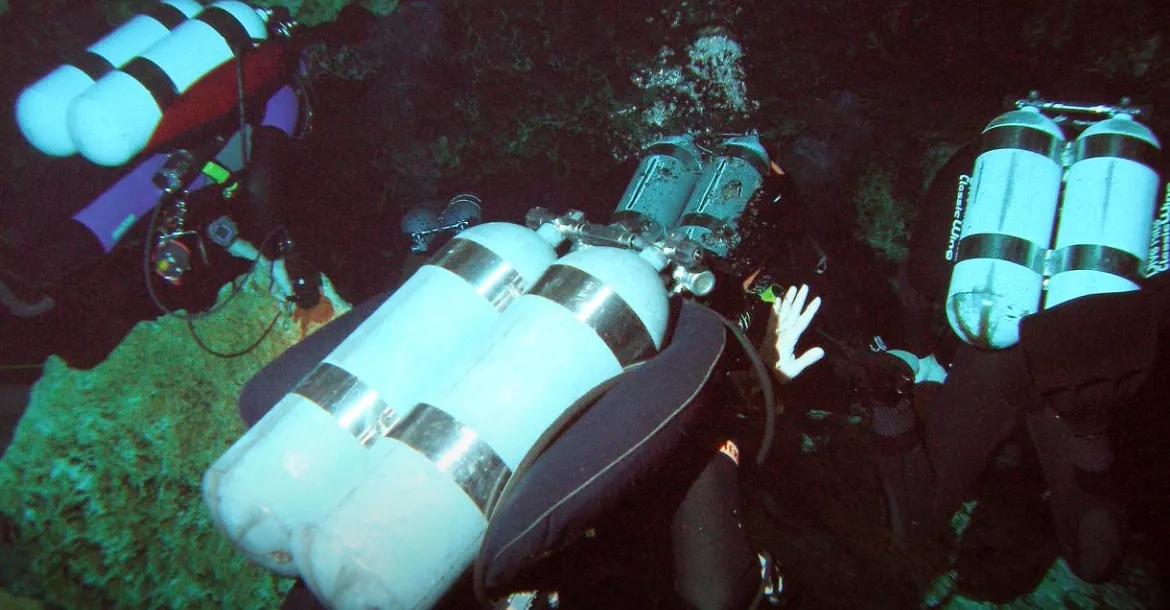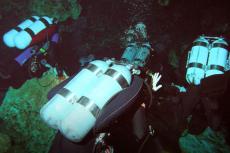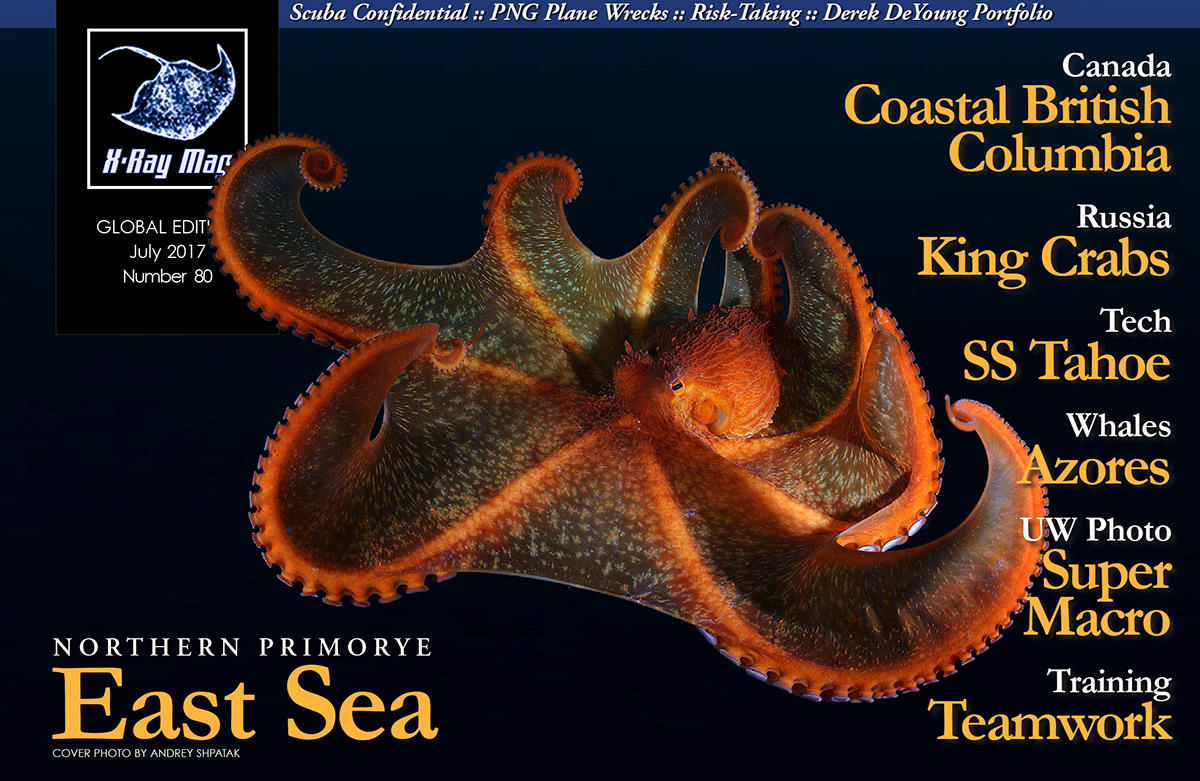There may not be an "I" in team, but there's one in "win", "live", "first" and "dive"!
Contributed by
Factfile
A resident of the Republic of Ireland, Matt Jevon, MSc., is an experienced and passionate open and closed circuit 100m trimix diver and full cave diver.
Whether using backmount, sidemount or his favourite JJ-CCR rebreather, Jevon believes technical diving is all about being safe, having an awesome dive and enjoying experiences few people share. Jevon holds instructor qualifications from TDI, PADI TECREC and IANTD, and partly owns South West Tech—a TDI dive centre in Ireland.
Jevon is also an approved JJ-CCR instructor and dealer. In addition, he is a sports psychologist, senior rugby coach and works in strategy and private equity.
For more information, please visit: Swt.ie and Mattjevon.com.
Over the years, I have had the privilege of being involved in some fantastic teams, sometimes in a leadership role, sometimes as an advisor helping to form a great team, and in others, as a team member. These teams have been engaged in pursuing objectives in sport, from international rugby to motorcycle racing and rally driving, through to high-performing teams in business. Over the last few years, I have enjoyed being part of dive teams, particularly in technical diving.
People often talk about teamwork as if it is a given—that is, if you gather a group of people together, with a little desire and intent, they will form a team. It is a dangerous assumption. High-performing teams have very defined characteristics, they operate in a very distinctive way, and they have many different cultures, values and styles. There is not a “one-size-fits-all” way of creating a team.
There is also a significant difference between a team we would consider cohesive and a team that is cooperating. I do not mention dysfunctional teams, as they are pretty easy to identify and, frankly, are not a team but just a group of people arguing and pulling in different directions. Cooperative teams are interesting to study, though.
Cooperative teams
Here, we have a group of people who work well together, who “get along”, often suborning personal beliefs and desires for the good of the team. What is wrong with that, I hear? Well, this team tends to follow one leader or gets behind the first credible idea, without really buying into it, without having really examined alternatives, without having challenged the thinking of the idea creator. In order to avoid intra-team conflict, they hold back their own ideas and desires, and often are not fully committed to the idea’s execution. These teams can operate well, but it does create frustrations among the team members, which at some point, will surface and fracture the team’s effort and motivation—usually when the soft and smelly hits the round and whirly.
Cohesive teams
In contrast, cohesive teams actively encourage the argument, discussion and deconstruction of ideas that lead to all feeling they have contributed, and therefore, are invested in the team’s activities. Personal beliefs and desires are never suborned for the benefit of the team, as clearly if this has to happened, the team composition is wrong and there is no role for the person expected to act and deliver against their desires. Cohesive teams perform consistently at a high level, whereas cooperative teams struggle to reach both high performance levels and certainly are inconsistent.
Recently, I have been diving with some GUE divers on some deep Croatian wrecks. GUE is very focussed on the team ethos, and I have had to adapt my more independently-minded approach to deep technical diving. It has been a different but pleasurable experience. Just because I am used to a team approach with different values does not mean I cannot contribute effectively to another team culture. What is important to allow me to do that is to understand the culture and expectations the team has of me within it; I need clarity.
This clarity is what, in my opinion (and in a fair bit of elite sports research), allows us to identify the key elements of a high performing team. These elements can easily be set in a variety of cultures and adapt to a variety of appropriate leadership styles. So, what are the elements?
Clarity of purpose. This is the most important element and the purpose cannot be doing whatever the leader tells them. Each team member must understand what the team wants to achieve, must believe in the possibility of success and be motivated and excited to play a role in achieving that success. There should be no doubt in all the team members’ minds what that clarity of purpose is and they should be able to articulate it clearly and succinctly.
Clarity of member and leadership roles. It does not matter what your role is, what is important that both you as leader and team member, as well as ALL the other team members and leaders, understand is what that role(s) is. The role will probably be related to particular skills and/or experience, but should also be related to the more team-oriented needs. Is your role to challenge through innovation, analysis or practicality? For example, one board of directors with which I work has the Chief Financial Officer challenge everything, not just from a numbers perspective, but also by looking at things not normally within the CFO role—where the person’s analytical thinking can challenge and add value.
Clarity of understanding of the power distribution in the team. As we are not living in a utopian society and most teams have some sort of formal or informal hierarchy, we cannot just wish this away. There is a distribution of power and influence in teams. This can be based on organisational position, ability, experience, etc. What this is must be understood exactly, by all team members. Only in this way can the “less powerful” understand their ability to challenge even the most powerful. And the “most powerful” can then realise the barriers to challenge and debate, which their authority creates. They can then work to demonstrate that they are open to be challenged and to have their thoughts, actions and desires critiqued by the less powerful. There is no need for one big charismatic leader either. If appropriate in small teams, such as we have in diving, it is more useful for different members to take the lead in different areas as befits their style, skills, knowledge and ability.
Clarity of communication. Once roles and power are understood, it becomes easier within the team for open and honest communication pathways. Often the biggest difficulty here is not with the message sender, but with the receiver. If emotion or arrogance get in the way of listening—i.e. “They can’t say that to me! Don’t they know who/what I am?”—then problems occur and communication barriers are raised. This is why it is easier to communicate by voice on contentious issues rather than by email, etc. The tone of challenge can be heard. The disengagement from listening can be seen and challenged. Anyway, there is potential for an entire book to be written on communication!
Clarity of culture and values. The word "culture" comes from the Latin word cultura, which means “to cultivate.” A shared culture is vital for cohesion. Values are what make up the team. Often in business, I see values talked about in a very trite fashion. For example, take “honesty.” It is a great value to have, but what does it mean in the context of this team and organisation? How is it applied? Measured? Upheld? If the team cannot use the values as a set of aspirational standards which guides their behaviour and actions, then those values have little true value! (Herein lies another book...)
A balance of approaches in terms of thinking. I do like George Patten’s quote, “If everyone is thinking alike, then someone isn’t thinking.” I like to ensure that people, who make up the teams that I am in, can bring different thinking styles. I like someone strong in creative thinking, someone strong in operational thinking and someone strong in analytical or reflective thinking. In that way, we get information from the analyst from which ideas can be generated by the creative thinker, a practical “how can we make that work” approach from the operational thinker and an ability to refine and challenge the process development from all. No one is 100 percent dominant in a style, but high-performing people tend to have a dominant style, and a strong secondary, plus often a considerable weakness in a third. It does not matter which one is dominant.
There is often an assumption that it is better to be creative. But as a creative person myself, I can tell you this is not necessarily true. We creative persons have difficulty sticking to a task if something new comes along.
Congruent motivational styles and directions. We have touched on this in a previous article, but suffice it to say, if you have three people, all highly externally ego-focussed, then trouble lies ahead. Think about whether people are ego- or task-driven and whether that is internally or externally focussed by them. Imagine what this means with regards to what they may want by way of reward, recognition, feedback and satisfaction.
Unnecessary elements
Interestingly, some of the elements that high-performing and cohesive teams do not need are often things inexperienced team builders or leaders try to create.They do not need to like one another. They do, however, need to respect one another’s abilities and desires to contribute to the team.
Social compatibility is of little relevance. I know people I get on well with socially that I would hate to work with, and vice versa.
Similar motivational reasons for achieving the team’s goals are not required. One team member might be ego-motivated, while another is task-motivated. What is important is that both persons can understand and appreciate the direction and intensity of the effort being put in by the team members.
To always be working with other team members. For some people, their best contributions are made through individual, focussed effort. It is their output that the team needs, not their companionship on a task or objective.
Lots of meetings... This is a real bugbear of mine. I hate lots of sit-downs where information is exchanged, but no decisions made or actions decided upon. All this does is interrupt people. These days, with modern technology, we have so many ways of sharing information more efficiently without a meeting. Share the information, then only meet if desired, to argue out the course of action. A decision is something you have to make if you do not have enough information! Hewlett-Packard has for many years operated some amazingly successful global teams across multiple time zones and cultures.
Team-oriented personalities. I am more independently-minded than team-focussed, but, when I see the reward for success being dependent on me being an effective team member or leader, I will be as valuable a team person as I can be. It’s all in the motivation!
Psychometrics. Psychometric testing, Belbin team roles analysis, etc—the degree of social compliance in psychometrics for me is unreal, and the academic models of roles are often reductionist, trying to either over-simplify or put people in boxes! Frankly, roles will change based on what the team is focussed on, at that place on the path to its objective or purpose. Sometimes people will lead, at other times, they need great followership skills. Make sure the box you put people in has an open lid!
Safe and effective diving
Well done if, as a diver, you have got this far and wondered... what does all this got to do with diving? Well, to me, all these components are essential for safe and effective diving, at both recreational and technical levels. We know problems occur in diving when team members step outside of the plans, but do we really consider why they do this?
It is easier to be annoyed and to berate them than it is to consider why they disconnected from the team. Perhaps they did not know, in the first place, what their roles were and why these roles were so important in achieving the team’s objective.
Let’s also remember our first objective in diving is always to come back alive and well from every dive. Perhaps they felt overwhelmed by more experienced divers who have become sloppy on planning or dive discipline, and they did not feel they could speak up, because they felt less powerful. I know this is a big issue for the “just culture” researcher and fellow X-Ray Mag contributor Gareth Lock is working so hard to establish in diving (see: http://www.xray-mag.com/content/just-culture).
All I can do is encourage you, if you dive within a team, to discuss the characteristics of a high-performing cohesive team described above with fellow divers. Answer for your team the questions that it raises. Establish the clarity or purpose, roles and communication. Look at the leadership and followership roles. Get the whiteboard or flipchart out—it will make a huge difference.
Perhaps you might identify the need to recruit a new member with desired and currently missing characteristics. Perhaps it will make you realise there are issues in your team you want to address or even that your team is not working. These are all good results and will strengthen your dive team and make it safer and more effective. Observe teams you admire and benchmark them against the team elements above.
I am up for answering questions or even helping teams work through these issues if desired: just pm me.
When all is said and done, have fun, dive safe. ■































